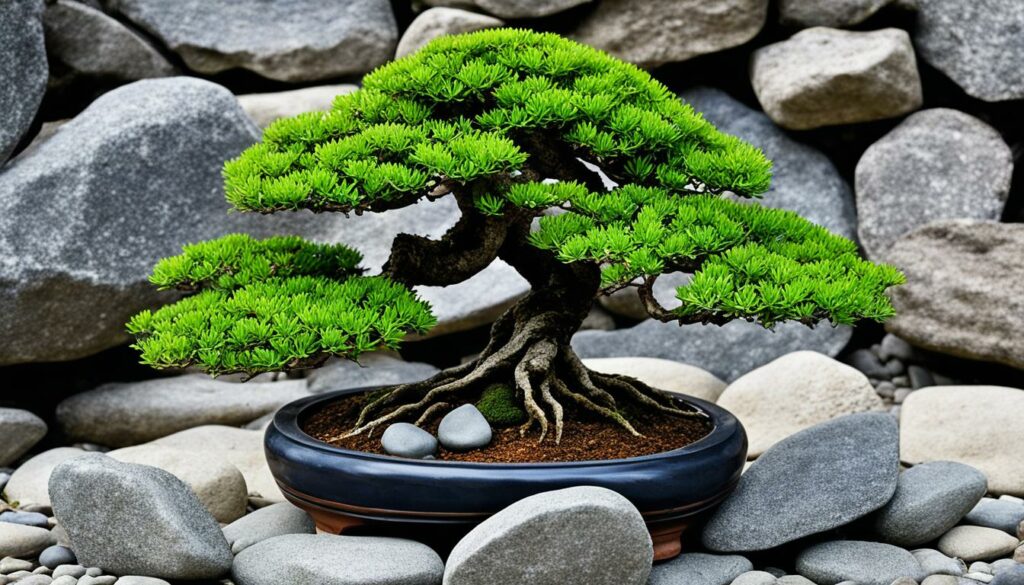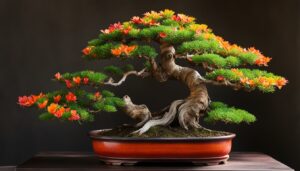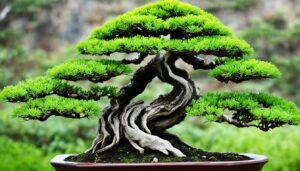Transforming your garden into a mountainous landscape can bring a natural and rugged element to your bonsai designs. Bonsai styling rock planting techniques enhance the beauty of bonsai trees through incorporating rocks into your design. In this article, you will learn the popular Ishizuki style, types of rocks used in bonsai, selecting the right rock for your bonsai, creating naturalistic rock formations, tools and materials needed, and how to maintain and showcase your creation.
Key Takeaways:
- Rock planting adds a unique element to bonsai designs.
- The Ishizuki style involves planting a bonsai directly on a rock.
- Choosing the right rock is crucial for creating a harmonious composition.
- Arranging rocks in a naturalistic way mimics the rugged beauty of a mountainous landscape.
- Maintenance techniques are required to keep your bonsai healthy and visually appealing.
Understanding Bonsai Styling
Before embarking on your journey to create a spectacular bonsai rock planting, you first need to understand the principles and techniques used in bonsai styling. Bonsai styling is the art of manipulating a miniature tree to achieve a specific aesthetic effect. Whether you want to create a mystical forest or a Juvenile group style, or in this case, a mountainous landscape with rocks, bonsai styling is the key to making your vision come to life.
Bonsai styling involves a deep understanding of the tree’s growth patterns and characteristics. Trees, like people, have unique qualities that make them unique. By learning to appreciate and work with the tree’s natural shape, you can create a beautiful, miniaturized version of a mature tree. Mastery of bonsai styling techniques requires patience, dedication, and practice.
There are various Bonsai styling techniques, including branch placement, trunk size reduction, and wiring. Branch placement requires the careful positioning of branches to achieve a natural look. Trunk size reduction trims the height and thickness of the trunk to create a more visually balanced appearance. Finally, wiring involves manipulating the branches and trunk to achieve a specific shape.
At the core of bonsai styling is the concept of creating an imaginary miniature tree that mimics the size, proportion, and shape of a full-grown tree. In essence, you’re creating a living work of art that reflects the natural beauty of the outdoors. Armed with these basic principles, you can now explore the world of rock planting with a better sense of how to incorporate this technique seamlessly.
Introduction to Rock Planting
In the world of Bonsai Styling Rock Planting, rocks play a crucial role in transforming your tree into a miniature mountainous landscape. Rock planting adds natural beauty and ruggedness to your bonsai designs, creating a unique element that draws the eye.
This technique is a popular choice among Bonsai enthusiasts and has been passed down through generations as an art form. The use of rocks in Bonsai design carries an essence of nature’s beauty, giving the artist a chance to replicate nature’s ruggedness and beauty in a small space.
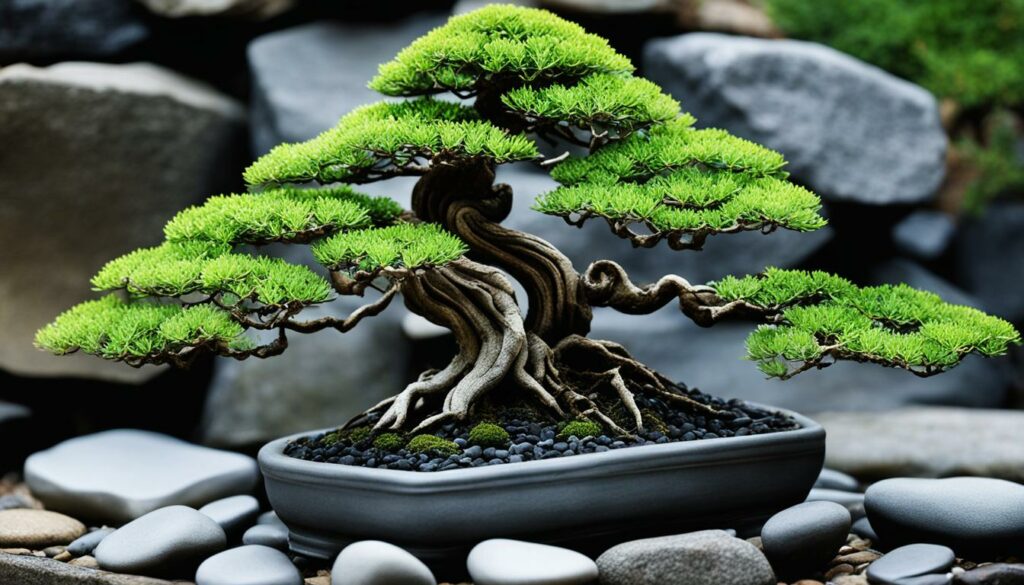
When it comes to rock planting, there’s no limit to the number of designs you can create. The shapes, sizes, and textures of rocks are all factors to consider in your final design. In the following sections, we will explore different types of rocks commonly used in Bonsai rock planting, how to select the right rock for your design, and the techniques to create naturalistic rock formations.
Types of Rocks Used in Bonsai
When it comes to rock planting, choosing the right rocks is crucial for creating a harmonious composition. There are different types of rocks commonly used in bonsai rock planting, including:
| Type of Rock | Characteristics |
|---|---|
| Volcanic Rock | Lightweight and porous, perfect for providing drainage and stimulating root growth. Popular choices include volcanic cinder and pumice. |
| Limestone Rock | Soft and easily eroded, they come in various colors (whitish, grayish, yellowish) that can help add texture and depth to your design. Examples include limestone and tufa. |
| Sandstone Rock | Durable and dense, they can come in various colors such as red, brown, or yellow that harmonize well with greenery. Suitable examples are sandstone, quartzite, or granite. |
| Slate Rock | Flat and irregular in shape with a distinct layered texture that can bring an eye-catching natural look to your design. |
Each type of rock brings its own characteristics to your bonsai design. Choose ones that complement the bonsai’s colors, textures, and shapes for the best effect.
Selecting the Right Rock for Your Bonsai
When it comes to rock incorporation in bonsai, choosing the right rock is essential for achieving a natural-looking and balanced design. Here are some key factors to consider when selecting rocks for your bonsai:
- Size: The size of your rock should be in proportion to the size of your bonsai. A large rock with a small tree may make the composition look unbalanced.
- Color: The color of the rock should complement the colors of your bonsai leaves, flowers, and bark. The contrast should be appealing to the eye, enhancing the overall visual impact.
- Shape: The shape of your rock should fit the style of your bonsai. For example, a bonsai with sharp angles and tight foliage should be paired with a more jagged and angular rock to emphasize its style.
- Texture: The texture of the rock should contrast with the texture of the tree. For instance, a bonsai with smooth bark should be paired with a rough and textured rock to create a harmonious composition.
By carefully selecting rocks that fit in with the style, color, shape, and texture of your bonsai, you can create a garden design that is both visually stunning and harmonious in its composition.
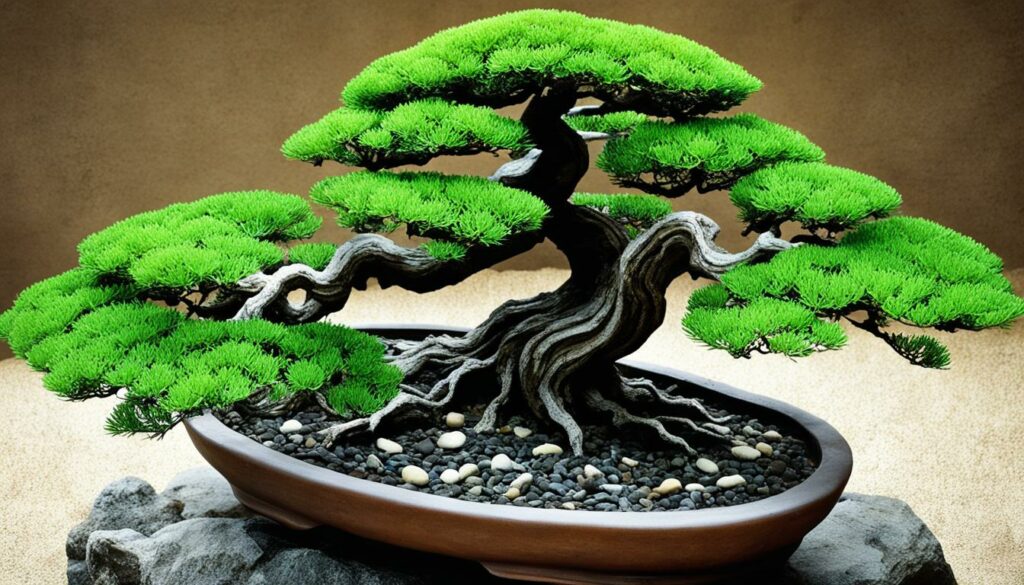
Now that you know what to look for in a rock for your bonsai, the next step is to understand how to create naturalistic rock formations. In the next section, we’ll explore techniques for arranging rocks to mimic the beauty of a mountainous landscape.
Creating Naturalistic Rock Formations
Rock planting is an intricate art form that requires a keen eye for natural beauty and careful consideration of scale, balance, and positioning. Naturalistic rock formations help to achieve a rugged mountainous landscape that complements your bonsai tree design.
The key to creating naturalistic rock formations is to mimic the way rocks are typically found in mountains and other natural landscapes. A good starting point is to consider the size and shape of the rocks you are working with. Look for rocks that have a naturally weathered appearance, as opposed to ones that are smooth or polished.
Next, consider the placement of the rocks. In nature, rocks are often found in irregular patterns that create a sense of depth and dimension. The same principle applies to rock planting. Rather than arranging the rocks in a perfectly symmetrical pattern, aim for a random yet balanced composition that mimics the natural world.
It is important to ensure that the rocks are securely anchored in place within the soil of your bonsai pot. This can be achieved by placing them into a shallow indentation and covering the base with a layer of soil, then carefully trimming any exposed roots to achieve a proper fit. Another technique is to use a combination of wire and anchor pins to hold the rocks in position.
Remember to take a step back and view your rock planting bonsai from different angles to make sure that everything is well-balanced and visually appealing. Adjust the positioning of the rocks as needed until you have achieved the desired effect.
The Ishizuki Style
The Ishizuki style is a traditional Japanese technique that involves planting a bonsai directly on a rock, where the roots of the tree are spread out and embedded into the crevices. In this way, the rock serves as both a foundation and a container for the tree, creating a unique and striking display of nature. This style is particularly popular among enthusiasts of mountainous bonsai, as the rock gives the illusion of a rugged and natural landscape.
The history of Ishizuki-style bonsai dates back to the Edo period, and it was developed as a way of creating a unified image of a tree and its environment. The practice of Ishizuki-style bonsai has since been refined and perfected by generations of Japanese bonsai masters, and it continues to captivate bonsai enthusiasts from all over the world.
One of the unique characteristics of Ishizuki-style bonsai is that the tree is planted without a bonsai pot. Instead, the rock serves as the container, and the tree is positioned and secured on the rock with wires and bonsai soil. This creates a striking visual effect, as the tree appears to be growing directly from the rock.
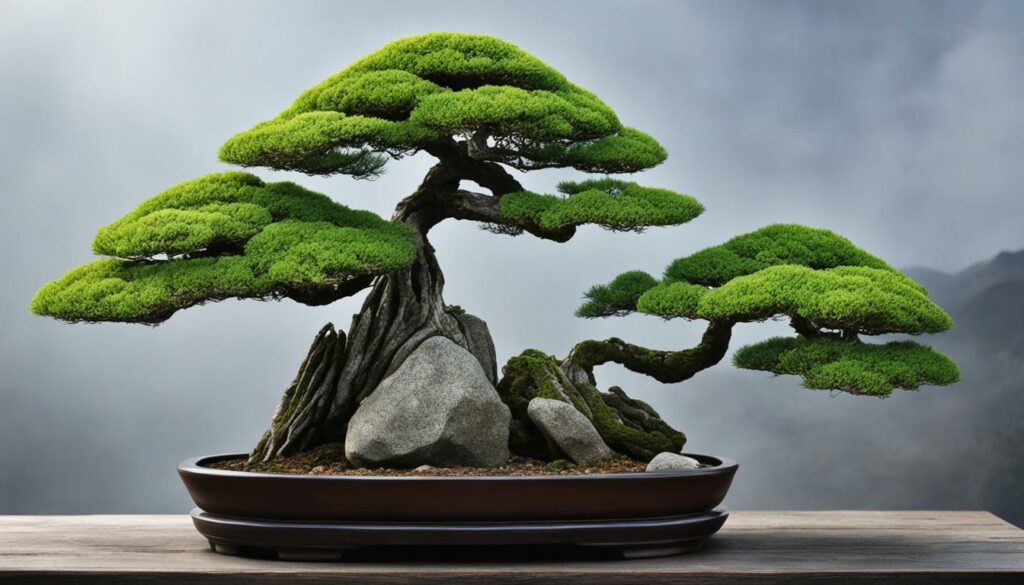
The Benefits of Ishizuki-style Bonsai
Ishizuki-style bonsai offers several benefits beyond its aesthetic appeal. First, it allows for greater flexibility in terms of design and composition, as the rock provides a natural backdrop and foundation for the tree. Second, the use of rocks in bonsai planting can help to create a more stable root system, aiding in the long-term health and survival of the tree.
“Ishizuki-style bonsai embodies the harmony between nature and art. It celebrates the beauty of the natural world and the creativity of human expression.” – Kenji Kuroki, Japanese Bonsai Master
Tools and Materials for Rock Planting
To create stunning rock planting bonsai, you need proper tools and materials. Here is a comprehensive list to help you get started:
| Tools | Materials |
|---|---|
| Bonsai pruning shears | Bonsai soil mixture |
| Bonsai wire cutters | Pebbles and gravel |
| Bonsai training wire | Bonsai fertilizer |
| Bonsai pliers | A bonsai pot |
| Bamboo skewers | Rocks |
These tools and materials will ensure that you have everything you need to create beautiful rock planting bonsai. Don’t forget to wear gloves and protective eyewear when handling wires and working with rocks.
Tip: When choosing rocks, look for those that have interesting shapes, textures, and colors that complement your bonsai’s design. Test different combinations of rocks and trees before settling on a final composition.
Preparing Your Bonsai for Rock Planting
Before transforming your bonsai with rock planting, it’s essential to prepare your tree to ensure a successful outcome. Follow these steps to ensure your bonsai is ready for the next stage:
- Repot your bonsai tree: Before adding rocks, it’s crucial to repot your bonsai tree into a container that will suit the final design, making sure it has adequate drainage holes.
- Check the roots: Trim back your bonsai tree’s roots and prune it lightly to ensure that it tolerates the new design without any damage, and wrap it in sphagnum moss.
Expert Tip: Before trimming the roots, make sure to untangle them first.
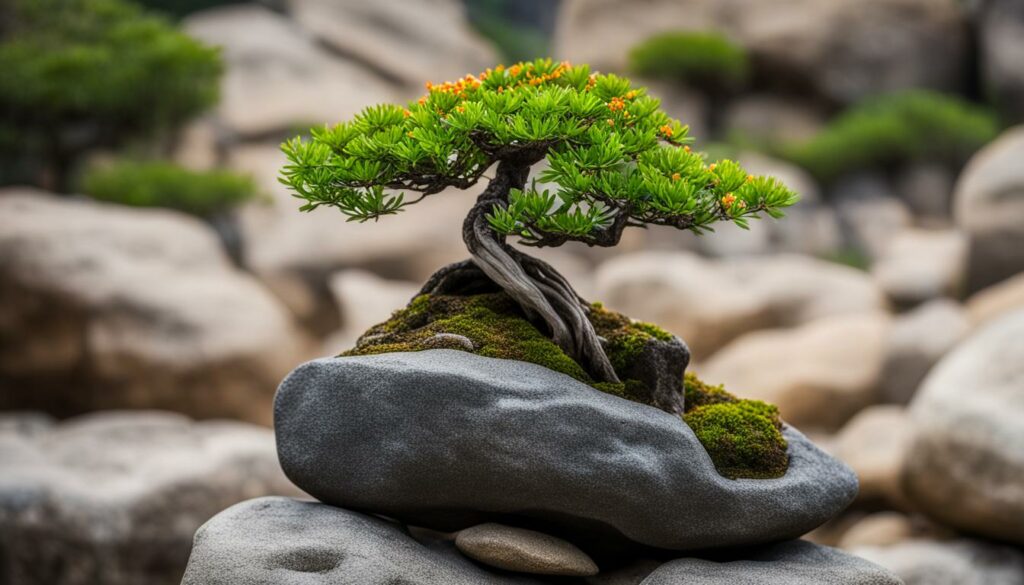
- Shape your bonsai: Depending on the vision, shaping your bonsai tree may be necessary to fit the rocks’ design. Ensure the branches are shaped in a way that will support the new arrangement without damage.
By completing these steps before adding rocks to your bonsai tree, you can ensure that the end result is healthy and visually striking.
Attaching the Bonsai to the Rock
In order to achieve the picturesque Ishizuki style, a traditional Japanese technique involving planting a bonsai directly on a rock, securely attaching your bonsai tree to a rock is vital. There are several techniques that can be used:
- Wiring: by wrapping wire around both the roots and the rock, you can create a strong bond that will last for years. It’s important to use low gauge wire and ensure it’s tight enough to keep the tree in place, but not so tight that it damages the roots.
- Mesh: mesh can be used to wrap around the tree’s roots and the rock, anchoring both in place. Plastic mesh is a popular choice as it’s less brittle and won’t crack over time.
- Root balls: creating a root ball can help to stabilize the tree and create a natural aesthetic. Simply wrap a wire mesh around the roots, soil and rock, and shape it into a ball. This helps to hold the tree in place and allows it to grow roots down into the rock.
Whichever technique you choose, it’s important to remember that creating a stable and long-lasting bond with the rock is crucial for the health and growth of your bonsai. Take your time, be patient, and don’t rush the process.
Building a Mountainous Landscape
Creating a mountainous landscape for your bonsai is both challenging and rewarding. With the right techniques, you can produce a breathtaking miniature scene that mimics the rugged beauty of a mountainside.
To begin, you need to understand the art of designing slopes, valleys, and peaks. The key to mountainous bonsai is to create a sense of depth and height using rocks and careful planting techniques. Consider using different size rocks to add variety and interest.
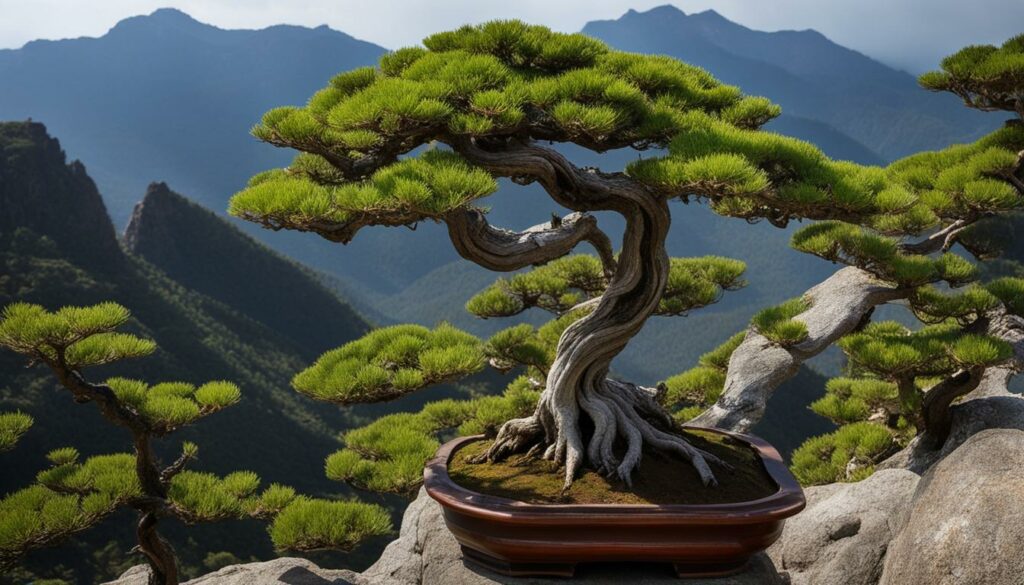
Start by creating a rough plan of your desired landscape. Take into account the shape and height of your bonsai tree, as well as the size and placement of your rocks. Begin arranging your rocks in a naturalistic way, keeping in mind the importance of scale, balance, and positioning.
Once your rock layout is complete, it’s time to start planting your bonsai tree. Use wire and pliers to carefully position the root ball of your tree onto the rock. Be patient and take your time to ensure a secure bond.
With a little care and attention, you can create a stunning mountainous bonsai that will be the envy of your friends and family.
Maintaining Your Bonsai Rock Planting
Once you have created your beautiful rock planting bonsai, it’s essential to learn proper maintenance techniques to ensure its longevity and beauty.
Watering: Bonsai trees require consistent watering to maintain their health and beauty, especially if they are planted in rock. You can’t water them as frequently as regular plants, but they also can’t be left to dry out. To avoid overwatering, use your fingertip or a moisture meter to test the soil moisture level. Water the bonsai thoroughly and wait until the soil surface feels dry before watering again.
Pruning: To maintain the shape and health of your rock planting bonsai, pruning is crucial. Trim unwanted branches that are obstructing the view of your rock and to improve the tree’s airflow. Use bonsai scissors or shears to avoid damaging your tree.
Fertilizing: Fertilizing your bonsai regularly is important for its growth and health. Use a slow-release organic fertilizer or liquid fertilizer according to the instructions provided. Stick to the fertilizer schedule to avoid over/underfertilizing your bonsai.
Repotting: Bonsai trees require repotting every 1-2 years to maintain optimal health and to avoid becoming root-bound. When repotting, use well-draining soil and trim back the roots and foliage to allow healthy new growth.
“Maintaining your bonsai rock planting may seem like a lot of work, but your efforts will pay off in the form of a beautiful and long-lasting creation.”
Showcasing Your Rock Planting Bonsai
Congratulations, you have successfully completed your Bonsai Styling Rock Planting project! Now it’s time to showcase your masterpiece and impress your friends and family. Here are some display options and tips to create an eye-catching presentation.
Display Options
There are various display options you can consider for your rock planting bonsai, including:
- Indoors: Display your bonsai on a windowsill or a table near a window where it can receive natural light.
- Outdoors: If you live in a warm climate, you can display your bonsai on a patio or deck. However, make sure to protect it from harsh winds and direct sunlight.
- Bonsai Stands: You can purchase a bonsai stand to display your bonsai indoors or outdoors. These stands come in various sizes and styles and can add an elegant touch to your presentation.
Display Tips
Here are some tips to create an eye-catching display for your rock planting bonsai:
- Use a plain, unglazed bonsai pot that complements the color and texture of your rock.
- Position your bonsai correctly so that its front is facing the viewer.
- Use accent plants or small figurines to create a sense of scale and add interest to your display.
- Consider using a small spotlight to highlight your bonsai and its rock formation.
Remember to keep your bonsai watered and well-maintained to ensure it stays healthy and visually appealing.
Troubleshooting Common Issues
Working with bonsai styling rock planting can sometimes present challenges. Despite your best efforts, you may encounter common issues such as:
- Soil erosion around the rock
- Roots not adhering to the rock
- Uneven growth of the tree
- Rock becoming loose
- Tree not thriving after being planted on the rock
Don’t fret, these problems are manageable. With a little effort and attention, you can troubleshoot and resolve these issues effectively. Let’s delve into some solutions to these common problems.
Soil Erosion Around the Rock
Sometimes the soil around the rock can erode over time, leaving the roots exposed and destabilizing the tree. To prevent this, try adding more soil mix around the base of the tree to stabilize it. You can also add mulch or rocks to the surface of the soil to help hold it in place.
Roots Not Adhering to the Rock
If the roots of the tree are not adhering to the rock, try adding more soil mix around the roots to encourage them to grow inwards and around the rock. You can also try gently tapping the roots against the rock to stimulate growth.
Uneven Growth of the Tree
If you notice uneven growth of the tree, try adjusting the wire around the branches to better guide growth. You can also prune the branches that are growing too quickly or remove wires that are restricting growth in specific areas.
Rock Becoming Loose
To prevent the rock from becoming loose, make sure it is securely attached to the tree and check the connections frequently. You can also add more wire or twist ties to the base of the tree to further secure the rock.
Tree Not Thriving After Being Planted on the Rock
If you notice the tree is not thriving after being planted on the rock, check the soil mixture to ensure it is providing the necessary nutrients and fertilizer. You can also try adjusting the placement of the tree to provide better light and humidity. Finally, make sure you are watering the tree thoroughly and consistently.
Expanding Your Bonsai Skills
Congratulations on mastering bonsai rock planting techniques! But don’t stop there, continue to expand your skills by exploring new techniques and styles. Here are some additional techniques to help you broaden your bonsai styling skills:
Cascade Style
The cascade style involves planting the bonsai with the trunk and branches cascading downwards, creating a waterfall-like effect. It’s a challenging but rewarding style that requires a lot of attention to detail and careful pruning. This style is perfect for showing off a tree’s natural beauty and creating a sense of motion in your design.
Multiple Trees
Grouping multiple bonsai trees together can create a more dynamic and visually striking display. This technique requires careful consideration of the size, shape, and placement of each tree to ensure a harmonious composition.
Shari or Jin Technique
This technique involves creating deadwood on the bonsai by removing bark and exposing the wood underneath. It can help create a sense of age and character in your tree, mimicking natural damage caused by weather or pests.
There are numerous other styles and techniques in the art of bonsai, each offering its own unique challenges and rewards. Keep learning and experimenting to take your bonsai styling skills to the next level!
Conclusion
Congratulations on taking the first step towards mastering the art of Bonsai Styling Rock Planting. By incorporating rocks into your bonsai designs, you can create a breathtaking miniature mountainous landscape that will impress any viewer.
In this article, you have learned about the principles of bonsai styling, the different types of rocks commonly used in rock planting, and the techniques required for attaching your bonsai to a rock. You have also explored the Ishizuki style and discovered the tools and materials needed for successful rock planting.
Remember, proper preparation and maintenance are crucial for the health and visual appeal of your bonsai rock planting. By following the techniques outlined in this article, you can expand your bonsai skills and take your creations to the next level.
Now that you have learned the basics of bonsai rock planting, it’s time to put your new knowledge into practice and create your own stunning miniature mountainous landscape. Have fun and enjoy the process!
FAQ
What is bonsai rock planting?
Bonsai rock planting is a technique that incorporates rocks into bonsai designs to create a mountainous landscape. It adds a natural and rugged beauty to the bonsai composition.
What is the Ishizuki style?
The Ishizuki style is a traditional Japanese technique where a bonsai tree is planted directly on a rock. It creates a unique and striking visual effect, mimicking a tree growing in a rocky environment.
How do I select the right rocks for my bonsai?
When selecting rocks for your bonsai, consider factors like size, texture, and color. Choose rocks that harmonize with your bonsai tree and create a balanced composition.
What tools do I need for rock planting?
Essential tools for rock planting include wire, pliers, soil mixtures, and bonsai pruning tools. These tools help you secure the bonsai to the rock and maintain its health and appearance.
How do I attach my bonsai to the rock?
To attach your bonsai to the rock, use wires to secure the tree’s roots to the rock surface. Creating a root ball and carefully positioning the bonsai on the rock will ensure a stable and long-lasting bond.
How do I create a naturalistic rock formation?
To create a naturalistic rock formation, arrange the rocks in a way that mimics the natural patterns found in mountainous landscapes. Consider the scale, balance, and positioning of the rocks to achieve a realistic effect.
What maintenance is required for bonsai rock planting?
Maintaining a bonsai with rock planting requires regular watering, pruning, and monitoring of its overall health. Proper care will ensure the long-term vitality and visual appeal of your rock planting bonsai.
How do I showcase my rock planting bonsai?
To showcase your rock planting bonsai, choose an attractive display option that highlights its unique features. Consider using accent plants, decorative moss, and appropriate lighting to enhance the presentation.
How can I troubleshoot common issues with bonsai rock planting?
Common issues in bonsai rock planting include root rot, improper attachment, and pests. By understanding proper watering techniques, ensuring secure attachment, and implementing pest control measures, you can effectively troubleshoot these issues.
What are some additional bonsai techniques to explore beyond rock planting?
If you’re looking to expand your bonsai skills, consider exploring other techniques such as cascade style, group plantings, and different pruning methods. These techniques will help you broaden your repertoire and create diverse bonsai designs.
